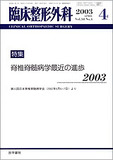Japanese
English
- 有料閲覧
- Abstract 文献概要
- 1ページ目 Look Inside
抄録:頚髄症に対する拡大術において術後成績に影響する因子のひとつに頚椎の矢状面alignmentが指摘されているが,いまだ意見が分かれている.われわれの頚椎非前弯型のなかには成績が不良な例があり,その術後MRIでは脊髄が頭尾側方向に緊張しているような所見が認められる.そこで今回,棘突起縦割法拡大術を施行した25例と前方固定11例の36例(頚椎症性脊髄症21例,例後縦靱帯骨化症15例)を対象に,頚部脊髄の頭尾長をMRIにて計測を試み,JOAスコア改善率との関係についてretrospectiveに検討した.頚髄長の術前後の差(術後-術前)(脊髄長差)は,拡大群が-21~3mm(平均±SD:-.0±3.4mm),前方群が-5~7mm(0.03±4.9mm)で,両群間に有意差はなかった.拡大術の頚髄長差2mm以上群(6例)の平均改善率は-53%で,拡大術2mm未満群および前方固定2mm以上群よりも有意に不良で,そのうち5例は直線型のOPLLであった.拡大術後に生じる脊髄長の増加は成績不良因子のひとつになりうると考えられた.
Objectives:We measured the length of the cervical spinal cord (LSC) as a new prognostic parameter.
Methods:Thirty-six patients (24male and 12 female) were operated on for cervical myelopathy at ages ranging from 33 to 76 years (mean 59 years), and the follow-up period ranged from 12 to 86months (mean 39months). Laminoplasty had been performed in 25 patients (LP group;in 13 for cervical spondylotic myelopathy[CSM]and in 12 for ossification of the posterior longitudinal ligament[OPLL]and anterior fusion had been performed in 11 patients (AF group;in 8 for CSM and in 3 for OPLL). We evaluated surgical outcome according to the recovery rate based on the scoring system for cervical myelopathy of Japanese Orthopaedic Association. Sagittal T2-weighted MRI were used to measure LSC as the sum of distances between lines that bisected the spinal cord at each intervertebral level from C1 and T1. We calculated the change in LSC by subtracting preoperative LSC from LSC at the most recent follow-up examination.
Results:In the LP group, the LSC changes ranged from -21mm to +3mm (mean -1.0mm, SD 3.4mm). In the AF group, the LSC changes ranged from -5mm to +7mm (mean +0.03mm, SD 4.9mm). There were no significant differences in LSC changes or recovery rates between the two groups. In the LP group, the 6 cases with a 2mm or greater LSC change had a significantly lower recovery rate than the LP group with less than 2mm changes and the AF group with a 2mm or greater change (Mann-Whitney U test) . Five of the 6 cases with a 2mm or greater change in the LP group had straight alignment and OPLL.
Discussion and Conclusion:High spinal cord tension, anterior mass, and dynamic motion may play an important role in impeding neurological recovery in cases with a 2mm or greater LSC change after laminoplasty. An increase in the length of the spinal cord after cervical laminoplasty may be a risk factor for poor surgical outcome.

Copyright © 2003, Igaku-Shoin Ltd. All rights reserved.


